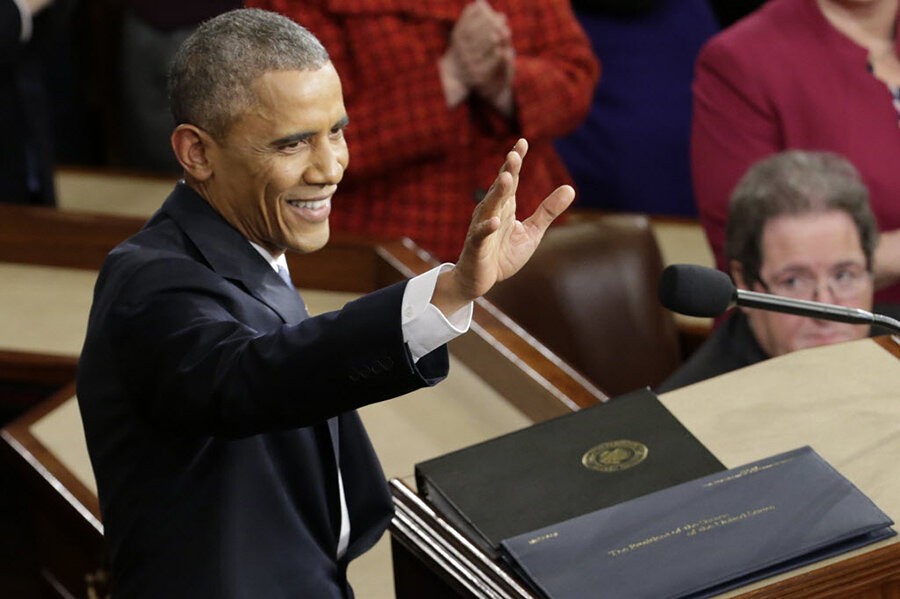How to watch the 2016 State of the Union online
Loading...
This year, President Obama’s final State of the Union address will have a newer, tech-ier feel, in keeping with how Americans watch media and debate a range of issues online.
Amazon is partnering with the White House to make the speech available to watch live and on-demand through its Instant Video service, in addition to on the White House’s site and YouTube channel, the administration said this week. As usual, it's also available on broadcast and cable networks and begins at 9 p.m. Eastern.
Noting that the State of the Union has an unusual history – it was abandoned by Thomas Jefferson in 1801 in favor of a report to Congress and resurrected in 1913 by Woodrow Wilson – the administration said a key goal for this year was to “meet people where they are” by making the speech available in a variety of formats.
“In this day and age, that starts by recognizing that even people following on two screens don’t just flip back and forth between a TV and a smartphone. We jump from different social media platforms — and we have shifting assumptions about the type of experience we’ll have on each,” wrote Jason Goldman, the White House’s chief digital officer, in a post on the site Medium.
The partnership’s goal of specifically addressing “cord-cutters” who have abandoned broadcast and cable TV is particularly timely. It comes several months after only one of the first three presidential debates this fall were available to non-cable subscribers, drawing ire from viewers.
The White House – which Mr. Goldman noted hadn’t even sent a tweet when Mr. Obama first addressed Congress in 2009 – has also beefed up its social media presence. It unveiled a new Snapchat account on Monday, with the first story showing preparations for the speech, in a bid to get the attention of the service’s large share of viewers between 18 and 24.
For political junkies – and other people interested in dissecting or debating the speech line-by-line – the president’s address will also be posted on the lyrics annotation site Genius (formerly Rap Genius). Previous speeches, dating back to the president’s 2009 joint address to Congress are currently available.
But unlike the site’s take on lyrics, the annotations are written by White House staffers. Genius users will also be invited to contribute and some of their reactions may be highlighted, Mr. Goldman noted.
Given the potential for criticism of the president for not living up to his stated goals in an increasingly harsh political climate, some of the annotations in previous speeches seem to reflect the administration’s talking points or downplay certain issues.
For example, during last year’s address Mr. Obama said of the controversial prison in Guantanamo Bay, Cuba, “I will not relent in my determination to shut it down. It is not who we are. It’s time to close Gitmo.” The resulting annotation, writing three days ago, notes that when the president took office, there were 242 detainees, while there are today 104, but continues with a more boilerplate response: “The Administration continues to work diligently on completing the plan to safely and responsibly close the detention center at Guantanamo Bay.”
Reportedly, the speech may also tackle some controversial tech-related issues, including efforts to curb social media posts and other online content by extremist groups. During a speech just after the shootings in San Bernadino, Calif., Obama said he hoped to partner with tech companies to “make it harder for terrorists to use technology to escape from justice.”
That was the topic of a meeting White House officials had with tech leaders from Apple, Google, Facebook, Microsoft and other companies in San Jose, Calif., last week. Microsoft’s head, Satya Nadella, is an invited guest for Tuesday’s address, with a White House blog post highlighting efforts by the tech giant to expand Internet access in schools and increase paid maternity leave, as well as the Indian-born executive’s immigrant roots.
The issues highlighted in the post could indicate that Obama could call on Congress and businesses to focus on two long-time priorities for the administration – expanding Internet access to low-income households and supporting workplace benefits for women, USA Today notes.
Goldman, the White House technology head, noted that in addition to shifting how the address is delivered, President Obama also hopes to use the speech to discuss broader goals beyond the next year, using the increased participation of online users as a springboard for that conversation.
“There’s a lot of valid criticism about all the noise in online media, and the risks — but there are countless examples of people embracing the clutter and using the Internet to come together to make positive change,” he wrote. “We believe that by “broadcasting” the State of the Union across social media and streaming video platforms we are helping American citizens connect to the government that serves them.”







